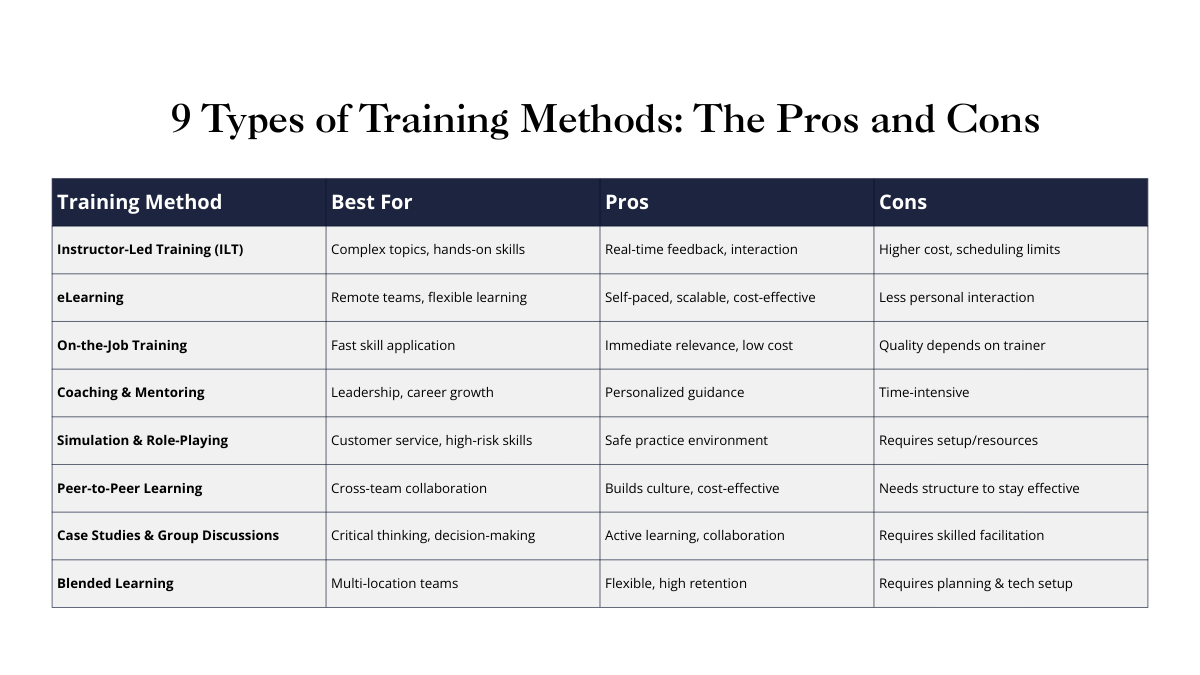BLOG
Discover 9 effective types of training methods to boost employee skills, engagement, and performance in the workplace.

Most cooperation training doesn’t engage and may end up boring employees. That’s why picking the right training method can make or break the success of your learning & development program.
Pick the wrong method and you risk low engagement, wasted budget, and employees forgetting most of what they learned within days. Pick the right one and you can boost retention rates, speed up skill application, and see a measurable impact on business performance.
The most effective training methods matter because they fit different learning styles and boost your team's participation and retention. Matching training types to your team's needs will give them information in their preferred learning format.
Let’s show you how to pick the quickest way to train your team based on your organization's specific needs and goals in this article.
As a Human Resource leaders, the training method you pick shapes how well people learn. It's an important aspect of your talent development strategy because companies that match their training methods to specific goals see up to 3x better returns than those using traditional approaches. The best method depends on your business goals, subject matter, training space, and who you're training.
Learning styles make a big difference in how well training works. People's priorities for learning include:
Training that lines up with these learning styles helps employees understand better, remember longer, and feel more confident.
Choosing the right training methods needs a smart strategy that works with several key factors. Here's a practical guide to help you make better decisions for your organization:
Your training should line up with your organization's strategic priorities. Getting a full picture of skills gaps and areas for improvement comes first. Set clear goals you can measure using the SMART methodology (Specific, Measurable, Achievable, Relevant, and Time-Bound). This approach will give a direct boost to business performance instead of just delivering content.
Your target audience's demographics, priorities, and professional experience matter. Age groups, education levels, job roles, and tech skills play a big role. Get into their current knowledge level, training attitudes, and learning barriers. These insights help instructional design teams create better employee learning objectives.
Review your budget limits, available time, and resources. Teams with packed schedules need training broken into smaller, digestible chunks. Your tech setup might call for simpler, more available methods. Note that not every organization can afford professional trainers.
The right methods should fit your specific needs. Each training type serves a purpose—coaching builds leadership skills while eLearning works best for company policies. Blended learning that mixes different methods often delivers the best results.
Here are 9 different types of training methods that you can consider for your employees. Not all training methods are equal so it's important to find the most effective ones to engage your high potential employees.

Instructor-Led Training (ILT) remains a cornerstone of education. Most of us have experienced this teaching method in high school classrooms or during company orientations. It simply means an instructor guides students through training materials in a classroom or online setting.
Research shows students remember 75% of what they learn through hands-on instructor-led training - better than other teaching methods. This explains why ILT makes up 34% of corporate training hours.
Instructor-led training shines through its various formats:
The human touch makes instructor-led training special. Teachers can adapt their pace to match student needs, answer questions right away, and create lasting learning experiences. ILT proves most valuable with complex, nuanced, or sensitive material.
Instructor-led training also comes with challenges like higher costs from instructor fees and venues, variations in teaching quality among instructors, and scheduling difficulties.
Technology keeps advancing, yet direct teacher-student interaction remains crucial for specific training needs, especially when students need hands-on practice to develop practical skills.

Technology has changed how organizations worldwide deliver training. Digital platforms now offer more flexible and affordable training solutions compared to traditional methods.
Recent studies paint an interesting picture. 70% of people prefer online or self-paced courses , while 62% like hybrid training programs. Many companies have started using these digital approaches to keep up with what their workforce wants.
The biggest advantage? Employees can access materials whenever they want, as long as they have internet access. This lets team members fit training around their work schedule. Digital training also cuts down on costs by removing the need for venues, travel, and printed materials.
eLearning comes in different shapes:
Most eLearning platforms use videos, quizzes, and games to keep learners involved. These interactive elements help people stay interested and remember what they learn better.
Digital training methods can cut learning time by 60%. They also provide detailed data about how learners progress. This mix of speed, engagement, and measurable results makes eLearning a vital part of any complete training strategy.
Employees learn best through hands-on experience by performing real work tasks, following the "learning by doing" principle that helps retain knowledge and improve performance in real conditions.
On-the-job training benefits organizations by enabling immediate skill application, speeding up learning. It's affordable, using existing equipment and staff as trainers. Employees also strengthen relationships with peers and leaders, boosting motivation and connection.
Organizations can implement this method via structured plans with checklists or by having new staff observe experienced employees without formal steps. Sales, manufacturing, technical, and customer service roles benefit most from these approaches.

Coaching and mentoring are distinct yet complementary methods for employee development. Though often used interchangeably, each serves a unique purpose in learning.
Coaches enhance job performance and skills through structured, performance-driven, time-limited interactions with evaluation. Mentors focus on long-term career growth and leadership by building trust, offering customized guidance to maximize traditional training through ongoing support.
Studies show that employees with learning opportunities stay longer at their companies. Nine in ten workers with career mentors are happy at work. Over 70% of those who receive coaching improve in work performance and communication skills.
Companies with formal coaching and mentoring programs benefit most. Employees are more engaged, efficient, build stronger workplace relationships, and are better prepared for leadership roles.
Job shadowing is a professional development practice where employees observe experienced colleagues performing their daily work. We focused on providing the "shadower" direct exposure to specific responsibilities and decision-making processes.
These are the key approaches that make job shadowing programs effective:
Job shadowing differs from internships as it's shorter and more observational. It provides benefits such as improved cross-functional visibility, risk-free skill building, and increased employee engagement.
Companies can foster internal mobility, optimize resources, and improve communication. Employees learn about processes, explore new careers, and build networks.
Teams can now use video conferences or pre-recorded sessions to shadow remotely, creating powerful learning opportunities. This training strategy benefits both individuals and organizations.

Peer-to-peer learning is based on a collaborative approach where people learn directly from each other instead of relying on traditional authority figures. This educational model encourages learners at similar levels to share knowledge. Employees play an active role rather than just passively consuming information.
Modern workplaces need this approach now more than ever. Research shows 87% of employees think learning and development is vital to their careers.
Research highlights peer learning's impressive results:
Organizations can use action learning groups, debates, discussion seminars, coaching partnerships, lunch-and-learns, and peer mentoring programs. Success comes from clear goals, experienced facilitators, and supportive frameworks.
Peer-to-peer learning provides economical solutions by using internal expertise instead of outside trainers. To cite an instance, 87% of companies say new hires work better with an onboarding buddy. This fact shows the real value of peer learning in detailed training strategies.
Case studies and group discussions serve as powerful collaborative learning tools in professional development programs. These approaches transform passive learning into active participation through real-world scenarios and shared problem-solving.
Learners face realistic case studies, analyzing problems and developing solutions to promote critical thinking. Research shows this helps participants understand decision implications while solving complex issues. Students retain concepts better when they actively apply, debate, and explain them.
The work to be done by facilitators includes:
Group discussions with case studies foster deeper understanding and participation. Breakouts enhance relationships and communication skills for ground situations.
These methods help participants turn theoretical knowledge into skills and effectively implement detailed training strategies.
Roleplaying helps people learn by doing. Participants take on specific roles in scenarios that build their skills. This approach lets you practice safely before tackling real-life situations.
Creating roleplaying scenarios that work requires trainers to:
It should be done in a psychologically safe environment to encourage experimentation and learning from mistakes. Good facilitators steer scenarios toward learning goals without taking control.
Roleplaying is better than standard training because everyone receives instructions, not just the person being watched.
Studies show roleplaying boosts confidence by experiencing workplace emotions and challenges. It helps develop soft skills through quick feedback on communication and problem-solving.
For example, salespeople role play different interactions with customers so they can use that training during real-life situations.

Lecture-style training has been central to education since the Middle Ages, with teachers verbally delivering information to learners with little interaction.
Lecture training offers clear benefits: students learn extensive material via a well-structured format. Experts convey complex info without classroom distractions. Large classes benefit from affordable methods.
This approach has drawbacks. Students learn less than half of what lecturers present. Lectures often cause boredom, reduce motivation, and students rarely participate. Many treat lecture content as something to memorize and forget, especially with information overload.
Quality lectures need these elements to work:
Great lectures do more than transfer information—they inspire students, challenge beliefs, and encourage evaluation and reflection. High-quality lectures should reshape the scene and develop critical thinking instead of just delivering information.
Blended learning merges various training methods to achieve optimal results. Organizations can customize learning by combining online and face-to-face methods to meet everyone's needs.
Virtual components reduce expenses on travel, venues, and printed materials, making this approach cost-effective. It also boosts student engagement through interactive content like videos, polls, and simulations that maintain interest.
The mix of different teaching methods offers several advantages:
Teams across various locations and time zones find this approach useful. Research indicates training impacts employee happiness and loyalty, making effective blended learning strategies vital for companies to stay competitive.
A review of training impact is important for successful learning programs. Organizations need proper measurement to understand if their training investments are working.
The measurement process starts with clear KPIs that align with business goals. Organizations need to track these key metrics:
Participant feedback provides a great way to get insights about training effectiveness. Post-training surveys capture immediate reactions, while delayed evaluations help assess learning transfer. The most valid results come from combining quantitative data (assessment scores) with qualitative information (participant feedback).
The review process should happen at multiple levels - from original reactions to behavioral changes and business impact. Organizations get the best results by measuring knowledge before and after training. The process should also review how employees use their new skills at work.
Analytical insights lead to continuous improvement. Organizations can spot program strengths and areas to improve by analyzing metrics and feedback. This ongoing process will give a relevant and meaningful training program, helping training professionals prove ROI through shown results.
Selecting the right training methods is vital for your organization's development. This piece explores approaches offering strengths for different learning goals.
A successful strategy begins with clear, aligned goals based on your audience, resources, and constraints. Different styles shape effective methods that enhance retention and application. Each serves specific purposes, from instructor-led to eLearning, hands-on shadowing, and peer learning. Role-playing and simulations provide safe practice, while coaching offers tailored guidance.
No single approach fits all, but successful organizations use blended models combining methods to meet diverse needs and reinforce learning.
Instructor-led training (ILT) is still the most widely used, especially for complex or compliance topics. That said, blended learning mixing ILT with eLearning and micro-learning is fast becoming the default because it scales, fits busy schedules, and reinforces learning over time.
Prioritize active and social methods: on-the-job training, simulations/role-plays, peer-to-peer learning, case studies with small-group discussion, coaching/mentoring, and micro-learning with quick quizzes. Layer in interactive elements (polls, scenarios, job aids) and spaced reinforcement to keep engagement high.
Continuous training is an always-on, iterative approach that delivers short, frequent learning experiences tied to real work. It uses micro-learning, nudges, just-in-time resources, and coaching to build skills progressively measured by behavior change and business outcomes, not just course completions.

Want our articles in your inbox? Sign up for our blog newsletter to never miss out!